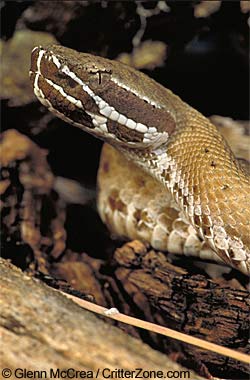Arizona ridge-nosed rattlesnake; photo © Glenn McCrea / CritterZone: Animal - Wildlife - Nature Stock Photography (all rights reserved; used by permission).
Official State Reptile of Arizona
The Arizona ridge-nosed rattlesnake (Crotalus willardi) was designated the official state reptile of Arizona in 1986. All State Reptiles
First known to science in 1905, this small brown snake is one of the most primitive rattlesnakes found in the United States The Arizona ridge-nosed rattlesnake is a unique species which is an important and irreplaceable part of North America's natural heritage.
Characterized by the strong white facial stripes and the distinctive ridge along each side of its nose, the Arizona ridge-nosed rattlesnake inhabits the moist pine-oak canyons of the Santa Rita and Huachuca Mountains in Arizona. It is well-camouflaged, but If discovered it will usually try to crawl rapidly away rather than present a defense. This snake's venom does not appear to be particularly potent and no human deaths from its bite are on record.
Scientists have identified 36 species of rattlesnake (rattlesnakes live only in North and South America). Thirteen species of rattlesnake live in Arizona (more than any other state).
Rattlesnakes Found in Arizona
Many snakes without true rattles vibrate their tail against leaves to produce a rattling sound as a warning. It's thought that early rattlesnakes, which lived in more rocky areas, developed a true rattle because of the lack of leaves or grass against which the tail could vibrate. The rattle is made of keratin (the same material found in human hair and fingernails). One can not tell the age of a rattlesnake by the segments of its rattle.

